MSI X79A-GD45 Plus Review: Building Up
by Ian Cutress on February 14, 2014 10:00 AM EST- Posted in
- Motherboards
- Intel
- MSI
- X79
System Benchmarks
Rightmark Audio Analyzer 6.2.5
The premise behind Rightmark:AA is to test the input and output of the audio system to determine noise levels, range, harmonic distortion, stereo crosstalk and so forth. Rightmark:AA should indicate how well the sound system is built and isolated from electrical interference (either internally or externally). For this test we connect the Line Out to the Line In using a short six inch 3.5mm to 3.5mm high-quality jack, turn the OS speaker volume to 100%, and run the Rightmark default test suite at 192 kHz, 24-bit. The OS is tuned to 192 kHz/24-bit input and output, and the Line-In volume is adjusted until we have the best RMAA value in the mini-pretest. We discussed the complexity of RMAA testing in a previous news post, but here we look specifically at the Dynamic Range of the audio codec used on board, as well as the Total Harmonic Distortion + Noise.
RMAA Dynamic Range of MSI X79A-GD45 Plus
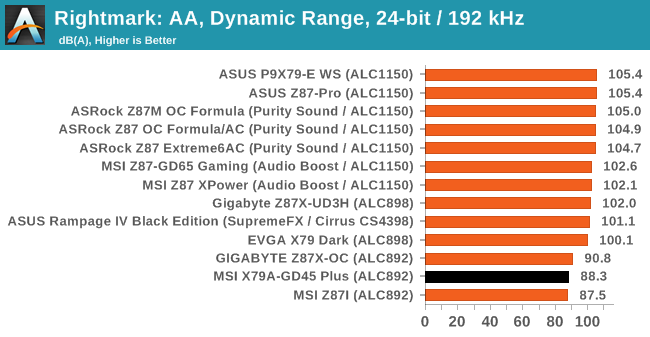
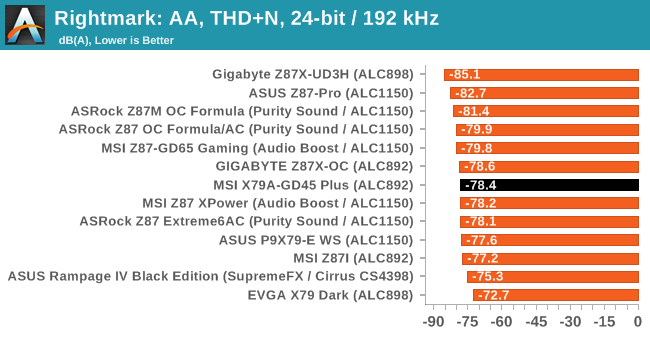
The MSI mimics other ALC892 motherboards such that the audio performance, particularly in dynamic range, is on the bottom of our scale.
USB Backup
For this benchmark, we run CrystalDiskMark to determine the ideal sequential read and write speeds for the USB port using our 240 GB OCZ Vertex3 SSD with a SATA 6 Gbps to USB 3.0 converter. Then we transfer a set size of files from the SSD to the USB drive using DiskBench, which monitors the time taken to transfer. The files transferred are a 1.52 GB set of 2867 files across 320 folders – 95% of these files are small typical website files, and the rest (90% of the size) are the videos used in the WinRAR test. In an update to pre-Z87 testing, we also run MaxCPU to load up one of the threads during the test which improves general performance up to 15% by causing all the internal pathways to run at full speed.
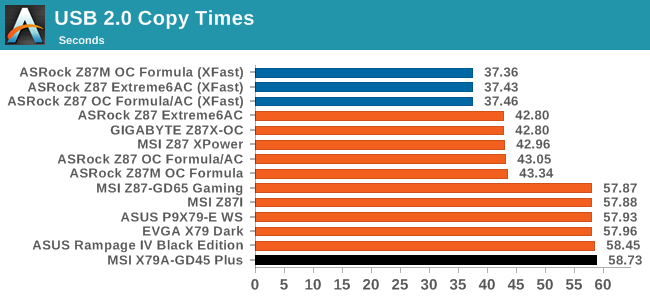
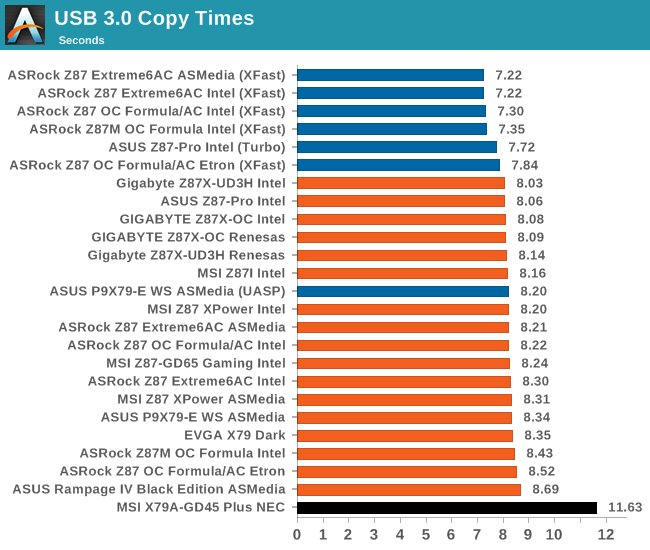
With our newer USB testing methodolgy, the MSI has the first NEC USB 3.0 we have seen and tested. The poor results speak for themselves.
DPC Latency
Deferred Procedure Call latency is a way in which Windows handles interrupt servicing. In order to wait for a processor to acknowledge the request, the system will queue all interrupt requests by priority. Critical interrupts will be handled as soon as possible, whereas lesser priority requests, such as audio, will be further down the line. So if the audio device requires data, it will have to wait until the request is processed before the buffer is filled. If the device drivers of higher priority components in a system are poorly implemented, this can cause delays in request scheduling and process time, resulting in an empty audio buffer – this leads to characteristic audible pauses, pops and clicks. Having a bigger buffer and correctly implemented system drivers obviously helps in this regard. The DPC latency checker measures how much time is processing DPCs from driver invocation – the lower the value will result in better audio transfer at smaller buffer sizes. Results are measured in microseconds and taken as the peak latency while cycling through a series of short HD videos - less than 500 microseconds usually gets the green light, but the lower the better.
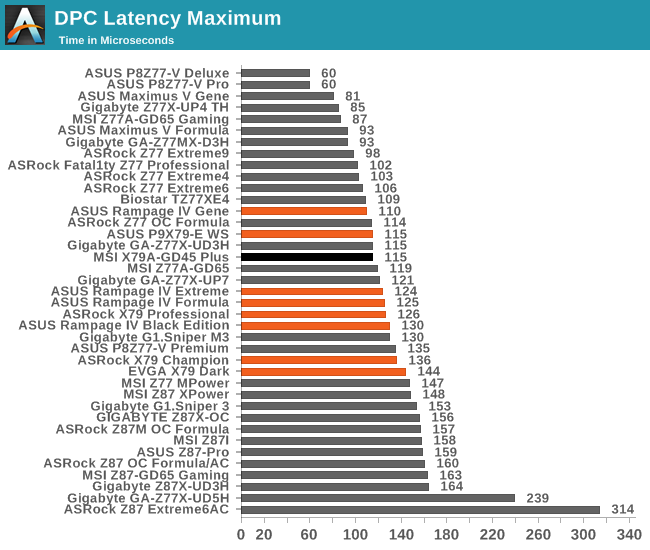











44 Comments
View All Comments
chuonglb - Thursday, March 6, 2014 - link
goodkizi: http://www.kizi10games.net
friv: http://www.friv200jogos.org
yepi: http://www.yepi10games.org
The PC Apologist - Saturday, February 15, 2014 - link
1) How many times have you seen me in the comments?2) Is complaining about poor English or bad grammar inherently bad?
3) Are my complaints illegitimate/inappropriate (calling good grammar bad)?
4) Do you come to this site expecting a pep talk or a well-written article?
5) Does you loathing me count towards the calculus of anything?
Thank you.
Ian Cutress - Friday, February 14, 2014 - link
Commonly people like to point out that I refer to companies using plural terms, as is the standard in the UK and persistent throughout my UK upbringing. No matter how hard I try and convert into singular style common in the US, it requires a complete reworking of my brain which I cannot do on the fly. So any attempt to try and patch the difference ends up half-baked, as it were.If you have specific suggestions, feel free to email by clicking on my name at the top of the article.
Ian
The PC Apologist - Friday, February 14, 2014 - link
No worries Ian.I appreciate the candor and sincerity. It’s nice to know that you’re open enough for constructive criticism and room for improvement, which can’t be said for everybody. But as far as writing goes, I suspect that the problem lies beyond just the confusion of singular vs. plural. Such can just be attributed to carelessness and be called honest mistakes. Rather, sometimes, there seems to be a lack of deeper substance and coherent flow. Other times, the language is simply not “beautiful,” but rather mundane and unenthused.
But like I said, for the time being, no worries. What’s important is that you’re open to suggestion and change. Writing is, among other things, an art, and it’s rather difficult to codify the formula for success. But with the correct attitude, one will eventually evolve and improve with practice, lots of reading (of good writers), and rigorous analytical thinking.
- The PC Apologist
Nfarce - Sunday, February 16, 2014 - link
PCA - just go start your own blog and STFU. We don't need your distractions, pompous jerkwad.khanov - Friday, February 14, 2014 - link
I think you are used to reading 'Americanese'. There is nothing wrong with Ian's English.The PC Apologist - Friday, February 14, 2014 - link
I think you are used to being "nice." There is nothing wrong with being honest from time to time.DMCalloway - Friday, February 14, 2014 - link
Unfortunately, the i7 2600k wasn't included in the benchmarks. This would have given the reader a clear overview of 2nd, 3rd, and 4th generation i7 performance for comparison.Ian Cutress - Friday, February 14, 2014 - link
Most of the results from other processors were derived from the retest required for the 2014 benchmark suite, initiated by the AMD Kaveri review. In time I will be going back and testing older CPUs when the backlog of review hardware falls to a reasonable level.The_Assimilator - Saturday, February 15, 2014 - link
Can you guys please start deducting points for motherboards that still include COM headers?